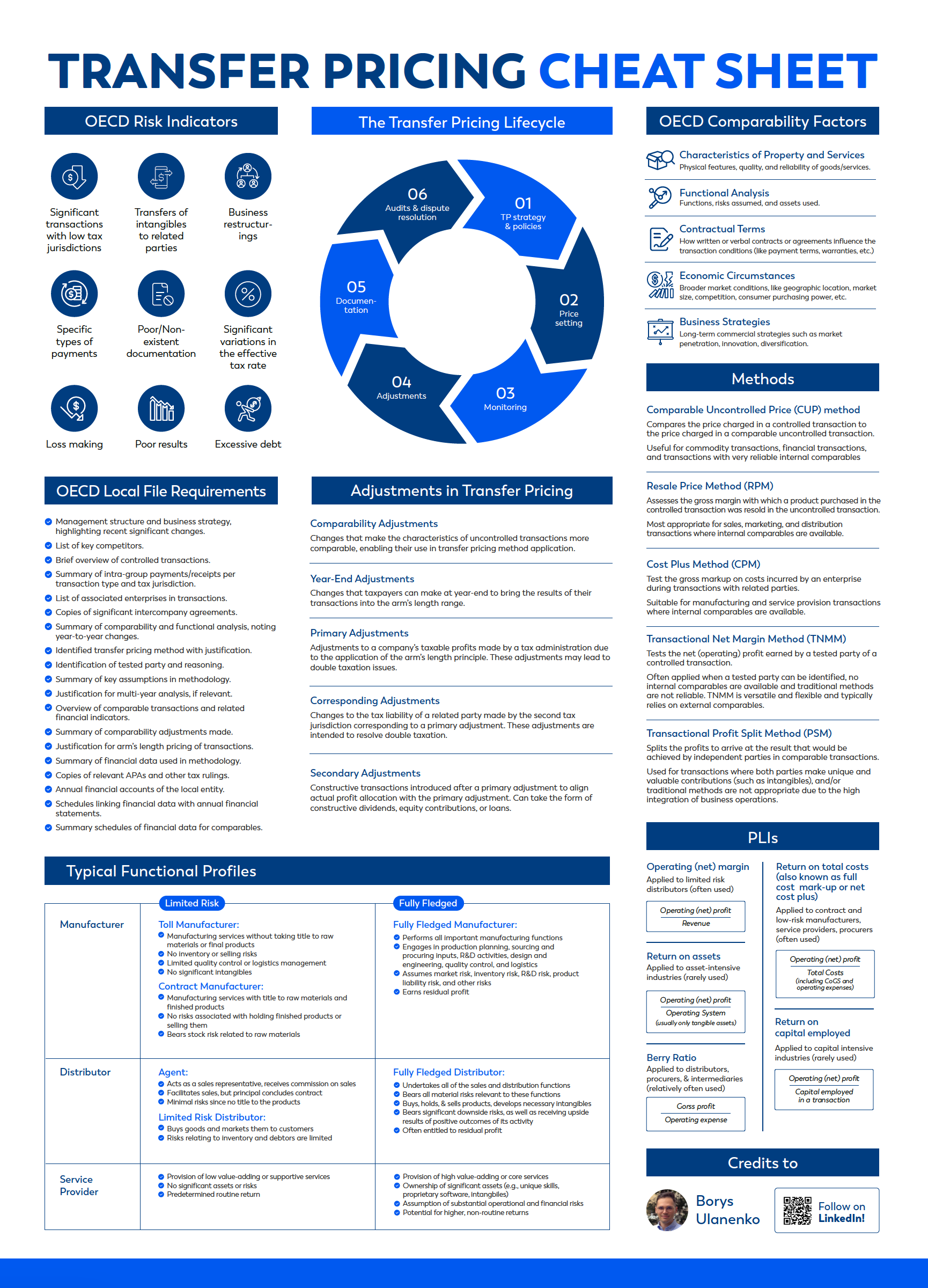A Typical Day in the Life of a Transfer Pricing Specialist
Feb 22
/
Borys Ulanenko
Contents
Discover the essential concepts of TP in one concise, easy-to-follow cheat sheet.
Quick Reference: Key Transfer Pricing Principles Summarized
Have all core TP concepts at your FINGERTIPS

Get your free TP cheat sheet!
Thank you! Download here.
We often think about how much work is involved in being a lawyer, accountant, or manager. They all have their difficulties and require time and patience to succeed. So what is it really like being a transfer pricing specialist?
In this blog post, I will explain some of the typical day-to-day tasks that are part of the transfer pricing specialist's responsibilities. This will give you an idea of what these professionals do daily and how challenging the work can be. Check it out if you consider joining the consulting or in-house transfer pricing team!

1. Important distinction: In-house vs Consulting work
As I was explaining in the other post on the transfer pricing career path, there are generally two types of roles where transfer pricing specialists work. They can either work in a consulting firm (like Big4, Grant Thornton, Baker Tilly, etc.) and help multinationals ("clients") manage their transfer pricing, or they can be employed by the clients themselves and do the work from inside ("in-house"). Of course, there are other options, such as working for tax authorities, legal firms, international organizations, and academia. Still, since they are rare and I don't have much experience with them, I'll focus on these two options.
In it's core, the main tasks and responsibilities of a transfer pricing analyst include for researching industry and market trends, staying updated on transfer pricing regulations, analyzing client data, creating financial models, pulling data and running comparable sets, and preparing client deliverables, usually in a report form.
In it's core, the main tasks and responsibilities of a transfer pricing analyst include for researching industry and market trends, staying updated on transfer pricing regulations, analyzing client data, creating financial models, pulling data and running comparable sets, and preparing client deliverables, usually in a report form.
While there are a lot of similarities between the two types of jobs, there are also important distinctions. I'll start with the typical activities of a transfer pricing consultant and then will explain how in-house roles are different.
2. Transfer pricing consultant - typical activities
2.1. Business development and marketing
Ultimately, consultants make money from selling their services to clients. Therefore, marketing and sales are an essential part of transfer pricing consultants everyday activities. This may involve meeting with prospects to understand their needs, preparing proposals, negotiations. On the marketing side, consultants would build their brand and show their expertise by publishing articles in professional journals, organizing and participating in conferences and webinars, running the company and personal blogs (and sometimes podcasts!). Remember that consultants are offering professional services. In professional services firms, sales and marketing activities are usually not delegated to specialist departments (such departments can still exist, but they primarily support the efforts of consultants but not replace them).
Also, note that the amount of business development work will significantly depend on the position level and the firm you are working for.
2.2. Project work
Once there is a project that consultants can work on, there are an infinite number of tasks that can be done in order to complete that project. In transfer pricing practice, these include data collection and research, preparing reports and presentations, managing communications with clients and internal partners, etc. Here are the main activities that transfer pricing projects may involve:
- Information requests
- Brainstorming, transfer pricing policy/strategy development
- Functional interviews
- Financial statement analysis and general financial analysis
- Benchmarking studies and economic valuations
- TP documentation drafting
- TP position papers preparation
- Accounting and financial systems design and implementation
- Periodical project meetings and phone calls with clients
- Addressing client's feedback
2.3. Administrative work
Consulting companies operate in a way that requires employees to perform some administrative tasks - for example, consultants have to fill in timesheets, do risk management activities, etc. Also, since the entire project timeline is almost never predictable, there may be periods where consultants have little to do. Most companies try to not let their employees sit idle and in these periods they assign administrative tasks ("non-billable work"). These can be anything from organizing the company events (e.g. Christmas party) to internal emails and reports responses to team offsites planning.

2.4. Self-development
As mentioned above, consultants are knowledge workers, and they need to continuously learn new things in order to be competitive. How do they do it? Consulting companies usually have training budgets, which allows their employees to attend conferences, seminars and workshops. This also involves gaining professional qualifications, like the Advanced Diploma in International Taxation (ADIT). Consulting companies often buy our transfer pricing course to train their new joiners and prepare for the ADIT exam. Also, consultants should always be up-to-date with the latest transfer pricing and international tax developments, so reading newsletters, professional articles, OECD reports is essential. The international transfer pricing environment is very dynamic.
We also should remember about the soft skills - like analytical skills and verbal communication skills.

3. How different is the in-house job?
The in-house work can sometimes be very similar to an external consultant's activities. For example, an in-house transfer pricing specialist also does a lot of "project" work described above, has to constantly develop technical skills (including deep industry knowledge) and stay up-to-date, and has administrative work relevant for his company. However, there are also important distinctions:
So the two types of work have some important differences, but the main activity is the same - transfer pricing. If you're interested in tax and love numbers, it may be a good idea to consider a career in transfer pricing.
- In-house specialists do not have business development and marketing in their scope - their constant "client" is the company they work for.
- Some transfer pricing activities can be more relevant than others. For example, if the company doesn't do in-house benchmarking studies and hire external consultants for this work, in-house specialists won't have to do them (but will ultimately have to manage consultants).
- More "process" work - in-house specialists tend to work with similar businesses and transactions, so there are many more opportunities for building processes, systems, and procedures. Generally, the operational transfer pricing can be more relevant for in-house roles.
So the two types of work have some important differences, but the main activity is the same - transfer pricing. If you're interested in tax and love numbers, it may be a good idea to consider a career in transfer pricing.
For more details about the transfer pricing profession, check out our Transfer Pricing Career Guide.
4. What sources are used to stay up to date on transfer pricing regulations?
Staying up-to-date on transfer pricing regulations typically involves consulting a variety of sources, as the regulations can be complex and are subject to change. Key sources include:
- Official Government Websites and Publications: Most countries have official government websites where they publish updates on tax laws and regulations, including those related to transfer pricing. For example, the IRS in the United States, HM Revenue & Customs in the UK, and similar authorities in other countries.
- International Organizations: Organizations such as the Organisation for Economic Co-operation and Development (OECD) provide guidelines and updates on international tax matters, including transfer pricing.
- Legal and Tax Advisory Firms: Many law firms and tax advisory services publish newsletters, updates, and articles on transfer pricing. These are typically authored by experts in the field and can provide both a summary and an analysis of recent changes and trends.
- Industry Journals and Magazines: Publications specific to finance, tax, and accounting often cover transfer pricing regulations and changes therein.
- Professional Associations: Bodies like the American Bar Association, Chartered Institute of Taxation, and other national or international professional associations often provide resources and updates for their members.
- Seminars and Conferences: Attending industry seminars and conferences is a great way to hear directly from experts and authorities on the latest in transfer pricing.
- Academic Publications: Research papers and articles from academic journals can provide in-depth analysis and insights into transfer pricing topics.
- Social Media and Online Forums: Following relevant hashtags or groups on platforms like LinkedIn, Twitter, and specialized online forums can be a quick way to get updates and engage in discussions with professionals in the field.
It's important to consult a range of these sources to get a comprehensive and accurate understanding of current transfer pricing regulations, as they can vary greatly between jurisdictions and are subject to frequent updates.
5. What databases does an analyst in the Transfer Pricing practice use?
Transfer Pricing analysts typically rely on a variety of databases to gather the necessary information for their analyses. These databases provide crucial data on comparables for benchmarking, financial information of companies, industry standards, and regulatory requirements. Some of the commonly used databases in Transfer Pricing practices include:
1. Bureau van Dijk (BvD) databases:
2. Thomson Reuters databases:
3. Standard & Poor’s Capital IQ: Offers detailed financial information on companies, industries, and markets worldwide.
4. Bloomberg Professional Services: Provides financial data, analytics, and insights, widely used for market and company research.
5. World Trade Organization (WTO) databases: Useful for information on global trade policies and regulations.
6. RoyaltyStat: Specializes in providing data on royalty rates and license fee comparables.
7. ktMINE: Focuses on intellectual property data including royalty rates, license agreements, and patents.
8. Compustat (by S&P Global): Known for its extensive database on financial and economic data for global markets.
9. IBFD (International Bureau of Fiscal Documentation): Provides comprehensive tax and legal information, useful for understanding transfer pricing laws and regulations across jurisdictions.
10. Local Government and Tax Authority databases: These are crucial for specific regional transfer pricing data and guidelines.
Each of these databases has its strengths and is used based on the specific requirements of the transfer pricing analysis, such as the geographical focus, industry sector, type of transactions, and the specific financial and legal data needed.
1. Bureau van Dijk (BvD) databases:
- Orbis: Provides comprehensive global company data, financials, and ownership structures.
- Amadeus: Focuses on detailed company information and financials across Europe.
- Osiris: Contains information on publicly traded companies worldwide.
2. Thomson Reuters databases:
- ONESOURCE Transfer Pricing: Offers a suite of tools for transfer pricing documentation and analysis.
- Datastream: Provides financial markets data and economic research.
3. Standard & Poor’s Capital IQ: Offers detailed financial information on companies, industries, and markets worldwide.
4. Bloomberg Professional Services: Provides financial data, analytics, and insights, widely used for market and company research.
5. World Trade Organization (WTO) databases: Useful for information on global trade policies and regulations.
6. RoyaltyStat: Specializes in providing data on royalty rates and license fee comparables.
7. ktMINE: Focuses on intellectual property data including royalty rates, license agreements, and patents.
8. Compustat (by S&P Global): Known for its extensive database on financial and economic data for global markets.
9. IBFD (International Bureau of Fiscal Documentation): Provides comprehensive tax and legal information, useful for understanding transfer pricing laws and regulations across jurisdictions.
10. Local Government and Tax Authority databases: These are crucial for specific regional transfer pricing data and guidelines.
Each of these databases has its strengths and is used based on the specific requirements of the transfer pricing analysis, such as the geographical focus, industry sector, type of transactions, and the specific financial and legal data needed.
Other common questions
- What deliverables do transfer pricing analysts in advisory typically prepare for clients?
Transfer pricing analysts typically prepare client deliverables in the form of reports. These reports contain their analysis, findings, and recommendations based on the research conducted and the client data analyzed.
- How much time do transfer pricing analysts spend in Excel and Word?
Transfer pricing analysts spend about half of their time in Excel, where they carry out data analysis and financial modeling. The other half of their time is spent in Microsoft Word, where they prepare client deliverables or conduct research online.
- What tools are commonly used by transfer pricing analysts?
Transfer pricing analysts commonly use Excel for data analysis and financial modeling. They also use Microsoft Word for preparing client deliverables and conducting research online.
For more details about the textbook and the course, contact us:

We are an online educational platform that helps professionals and aspiring individuals to succeed in their goals.
Featured links
Get your free TP cheat sheet!
Discover the essential concepts of TP in one concise, easy-to-follow cheat sheet.

Thank you! Download here.
What is the EU Directive?
The EU is run by an elected EU Parliament and an appointed European Council. The European Parliament approves EU law, which is implemented through EU Directives drafted by the Commission. National governments are then responsible for implementing the Directive into their national laws. In other words, EU Directives are draft laws that then get passed by national governments and then implemented by institutions within the member states.
What is CbCR?
Country-by-Country Reporting (CbCR) is part of mandatory tax reporting for large multinationals. MNEs with combined revenue of 750 million euros (or more) have to provide an annual return called the CbC report, which breaks down key elements of the financial statements by jurisdiction. A CbC report provides local tax authorities visibility to revenue, income, tax paid and accrued, employment, capital, retained earnings, tangible assets and activities. CbCR was implemented in 2016 globally.
